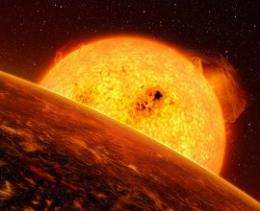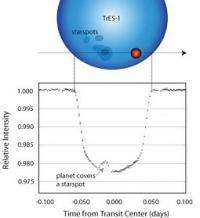Alien Planet Safari

The premiere observatory of the next decade, the James Webb Space Telescope, will launch in 2014 in search of "big game"--namely, the first stars and galaxies ever formed in our Universe. But the "little game" could turn out to be just as interesting. There's a dawning awareness among astronomers that the world's largest infrared telescope is going to be a canny hunter of planets circling faraway stars.
"Webb was originally conceived to search for the first galaxies and address the big cosmological questions associated with them, but we now know it can contribute powerfully to the planet hunt," says Mark Clampin of NASA's Goddard Space Flight Center. "Exoplanets are tremendously exciting. The field is changing literally by the day. I gave a talk on exoplanets the other day, and in the time between writing and delivering the speech, astronomers announced 30 new planets!"
The Webb telescope is the tool for carrying out detailed, high precision follow-up studies of these new planets other telescopes are flushing out of hiding. And such planets are sneaky -- hiding in the glare of their own "suns."
"It's like trying to find a firefly's flash in the beam from a lighthouse," says Jonathan Gardner, Webb Deputy Senior Project Scientist from Goddard. "But there are ways to do it!"
One way is called "transit science," which means studying the light from a star when a planet passes in front of the star.
"Webb will measure the total light the star emits and then measure the amount of light when the planet crosses in front," explains Gardner. "This telescope can even detect brightness changes that occur when the planet passes behind the star. With some Doppler measurements from ground-based surveys, all this information helps us determine the planet's mass and radius, and then astronomers can start to think about the planet's composition."

"We can also do spectroscopy during the transit," Gardner continues. "We measure the spectrum of the starlight before the transit, then again when the starlight is filtered through the planet's atmosphere during the transit."
The starlight changes as it goes through the planet's atmosphere.
"By comparing the two spectra for the star (in and out of transit), we can extract the planet's spectrum and learn about the planet’s atmosphere," says Clampin. "We have to collect a lot of infrared light -- a billion or more photons -- for each spectral element to isolate features. Webb is perfect for this kind of study."
The telescope's huge 25 m2 collecting area can round up the herd of photons needed. And because Webb will be kept extremely cold thanks to its enormous sunshade and its location at the L2 Lagrange point, no extraneous source of heat will contaminate signals from the cosmos.
"We're thrilled at Hubble's science, but we need low thermal background to see the faint infrared things we want to see," says Clampin. "And Hubble starts to see its own thermal signature at a certain point because it's not a very cold telescope.
"Webb will show us what the 'exoplanet zoo' looks like. This telescope will be very good at observing and taking spectra of gas giant planets, and we can take some spectral data on smaller planets, too, about Neptune-sized. Our telescope will also zoom in to study newly discovered super Earths' - planets bigger than Earth but smaller than Neptune."
Webb can also find planets on its own. "The Webb telescope will use a technique called coronagraphy to look for gas giant planets," says Gardner. "A star's light is so brilliant that it outshines any nearby planet by a million to a billion to 1, but inside three of Webb's four cameras there's a black spot the light can't go through. We'll put the star behind the black spot so we can see the planet next to the star. It's like when a car is driving toward you at night with its high beams on, and you use your hand to block out that light so you can see the road."

"Our eventual goal is to look for chemical evidence of life on some of these new planets. But we're not sure yet how well we'll be able to do that."
"Can Webb find signs of life on a planet like Earth?" asks Clampin. "The answer is probably not. A true Earth twin would be too small to emit enough infrared light from its atmosphere for Webb to pick up."
"Still, every time scientists make statements like that, someone proves them wrong. Transit science is changing so fast, it's hard to say exactly what wonders Webb's hunt will turn up."
Source: Science@NASA, by Dauna Coulter



















